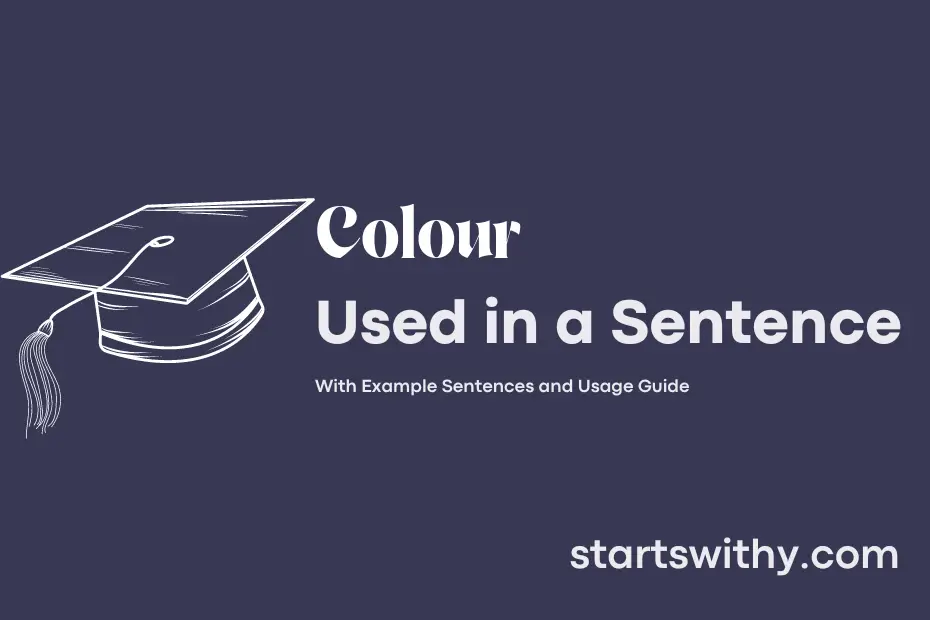Have you ever wondered how adding a pop of color can completely transform a room or an outfit? Color, in its simplest definition, is the visual perceptual property corresponding in humans to the categories called red, blue, yellow, etc.
When we incorporate color into our surroundings, it stirs emotions, conveys messages, and sets the tone for our experiences. From vibrant hues that evoke energy and excitement to calming shades that promote relaxation and tranquility, color plays a crucial role in our daily lives.
7 Examples Of Colour Used In a Sentence For Kids
- Colour the sun yellow and the sky blue.
- Use your favourite colour to draw a big smiley face.
- Let’s mix red and yellow to make the colour orange.
- Find all the different colours of flowers in the garden.
- Can you name the colours of the Indian flag?
- The colour of ripe bananas is yellow.
- Drawing with lots of colours is so much fun!
14 Sentences with Colour Examples
- The colour of the sky during sunset was absolutely breathtaking.
- I need to buy new colour pencils for my art project.
- The colour scheme for the college cultural fest is going to be red and gold.
- Don’t forget to wear traditional colour attire for the ethnic day celebration.
- I love decorating my dorm room with bright colourful lights.
- The colour of the walls in the lecture hall is a calming shade of blue.
- I can’t decide which colour backpack to buy for the new semester.
- We should all wear a specific colour to show our solidarity for the upcoming march.
- The pages of my textbooks are full of colourful diagrams and illustrations.
- The colour of the curry in the canteen looked too spicy for my taste.
- The professor asked us to highlight the keywords in our essays with a different colour.
- I prefer taking notes in various colours to make studying more engaging.
- The colour of the library walls makes it a cozy place to study during winter.
- Let’s pick a colour theme for our college group project presentation to make it visually appealing.
How To Use Colour in Sentences?
Colour is a word that refers to the different shades and hues that we see in the world around us. When using the word colour in a sentence, it’s important to pay attention to how you spell it because it can be spelled differently in British English (colour) versus American English (color).
To use the word colour in a sentence, start by thinking about what you want to describe. Is it an object, a feeling, a person, or a place? Once you have that in mind, try to visualize the colour that you want to convey in your sentence. For example, “The sky is a beautiful shade of blue” or “She selected a bright yellow dress for the party.”
When writing a sentence with colour, remember that colour can evoke different emotions and meanings, so be mindful of the context in which you use it. Consider the symbolism of different colours – for example, red is often associated with passion and love, while green can represent growth and nature.
Experiment with different colours in your sentences to create vivid images and convey your intended message clearly. Practice using colours in various contexts to become more comfortable with incorporating them into your writing. With time and practice, you’ll be able to effectively use colour in your sentences to bring them to life.
Conclusion
In conclusion, sentences with color are an excellent way to vividly describe objects, scenes, and emotions in writing. By using descriptive language that incorporates colors, writers can create imagery that enhances the reader’s experience and brings their words to life. Whether it’s a “vibrant red rose” or a “stormy grey sky,” color-filled sentences add depth and interest to the narrative.
Additionally, sentences with color can also convey mood and atmosphere, setting the tone for a story or painting a picture for the reader. This use of color in writing helps to engage the reader’s senses and create a more immersive reading experience. Overall, incorporating color into sentences is a powerful tool for writers to create vivid and memorable descriptions in their work.



